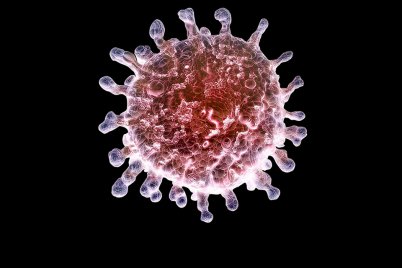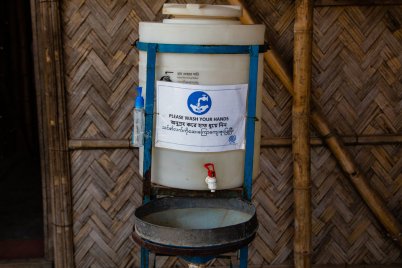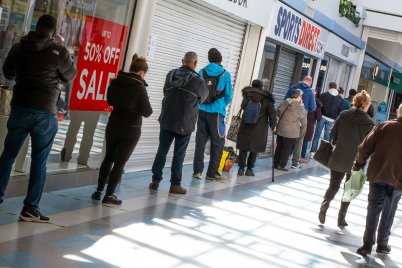
Vaccination viles sit on top of two freezer packs in an attempt to keep them cool in the humid climate of the outdoor ward in Basse Hospital, The Gambia. Credit: Louis Leeson/LSHTM.
This feature is available for republication under a Creative Commons licence.
In the tropical Samoan rain, children in faded t-shirts and shorts play happily in their backyards. Part of their ‘playground’ are the raised graves of relatives buried yards from their homes. In this island nation in the Pacific Ocean, it is traditional to keep the dead close by in their household plots.
But there are newer, more pristine resting places, often with plastic flowers covered in cellophane to protect them from the frequent downpours in the rainy season, that they leave alone. These mark those who died of measles – 83 young lives lost in just four months late last year.
Of the affected families, most only lost one child. But in Lauli’i village, a short drive from the capital Apia, Fa’aoso Tuivale has laid to rest her 13 month old twins Tamara and Sale and three year old brother Itila, leaving two older brothers.
The family has built a little mausoleum with a corrugated iron roof and glass windows a couple of metres from their home, with donations from well-wishers.
Tuivale says a Ministry of Health mental health team visited to talk through what had happened. “Just talking and offering us sympathy helped, they told us how to move on.”
Sheldon Yett, UNICEF representative for the Pacific Island countries, said Samoa became the ‘poster child’ of what can happen in an under-immunised population. The infection was believed to have been imported from New Zealand where there was an outbreak of the same strain earlier in 2019. That November, the World Health Organization (WHO) said measles vaccine coverage in Samoa was just 31%.
Beate Kampmann, Professor of Paediatric Infection & Immunity, and Director of the Vaccine Centre at the London School of Hygiene & Tropical Medicine, says it was a harsh lesson.
“What we clearly learned from the Samoa measles outbreak is that vaccines matter for individuals and communities. They work and if you don't give them, you lay your population open to devastating infections that are entirely preventable.”
The context of the vaccination programme in Samoa was complex. Vaccination was generally well-established and supported. Like many others, in the Tuivale family the older children were vaccinated with MMR but the twins were not, following the well-publicised case of two babies dying immediately following the vaccination in 2018. The immunisations were wrongly prepared – unintentionally – by nurses who were later jailed.
Immunisation rates declined as the MMR programme was interrupted for eight months while the incident was investigated, but even when the programme resumed, parents were scared to vaccinate – a double blow.
Fa’aoso Tuivale says, “It’s hard to explain. I did not want to see the same happen to my children. It was hard to accept.”
Public health responsibility for vaccine uptake
When mistakes are made, it is vital that governments properly inform the population in a proactive way and are honest that some ‘terrible mistake ’ has happened, says Prof Kampmann, rather than allow the perception that nurses were harming children.
Samoa was not a one-off in being a country where a vaccine scare had a wider impact. In the Philippines, childhood vaccination rates dropped off significantly in 2017, following withdrawal of the dengue vaccine Dengvaxia a year after its introduction, due to new evidence communicated by the manufacturer of an increased risk of hospitalisation and severe illness in vaccinated children never infected with dengue. The WHO later advised it should not be administered to people who have not previously been infected with dengue.
While the risk could have been managed with a change in guidance around use, the news created public outrage and breakdown of trust. This led to parents refusing other vaccines including for measles, leading to a significant measles outbreak in 2019 where 70 people died, mostly children.
A study in the Journal of Human Therapeutics and Immunotherapeutics found that those who believed “that vaccines are important, are safe and are effective” in the Philippines had dropped from close to 100% in 2015 to 60–80% in 2018.
Lead author of the Philippines research was Heidi Larson, Professor of Anthropology, Risk and Decision Science in the Department of Infectious Disease Epidemiology at LSHTM.
She says there was a lot of media noise about the influence of anti-vaxxers in Samoa but in fact the decline in community support for vaccination was more about the anxiety and fear provoked by the children dying following vaccination, and the time lag in acknowledging the problem and clear information that it was human error, not because of the vaccine itself.
Prof Larson says, “It was not started by a group of so-called anti-vaxxers. People have to remember that that whole outbreak started because of a genuine problem – children died due to the nurses not getting enough training and feeling rushed while they prepared the vaccines. These nurses who dedicated their lives to a public health profession are now jailed, although they certainly had no intention to cause harm.
“As a public health community, we have to acknowledge our own responsibilities in these issues.”
Measuring community support for vaccines
Prof Larson is Director of The Vaccine Confidence Project, a research group linked to the Vaccine Centre. It was set up to monitor public confidence in immunisation programmes worldwide.
A pivotal moment was the publication in 2016 of a paper called the State of Vaccine Confidence, a global study in 67 countries, mapping public sentiments around the importance, safety, and effectiveness of vaccines in an index.
Since then it has become a highly cited reference paper, is often used as a baseline, and has motivated a number of countries to take more action to boost community support for immunisation. The EU has commissioned follow-up work in 2018 and 2020, and the Wellcome Trust used the index in 144 countries in their global study on trust in health and science.
The Philippines used the baseline in multiple ways to measure confidence levels after the dengue vaccine scare and to see whether their subsequent trust building efforts were having an impact.
Communication skills around safety concerns in relation to vaccines are ‘poorly developed’ in all settings, and is something that the Vaccine Centre wants to work on, according to Prof Kampmann.
Innovative multimedia promoting science in the field
The Vaccine Centre was established to provide an authoritative voice for cutting edge vaccine science, and to act as a multiplier of vaccine knowledge. Members working in its three themes– innovation, application, and evaluation – aim to improve human and animal health through vaccination.
It gives prominence to the work of more than 100 member scientists, internal and external to LSHTM, working across faculties and in partnership around the world. They are visible through podcasts and other multimedia, such as a recent Facebook Live with the BBC. Subjects range from vaccines for different stages in life, vaccine-preventable sexually transmitted diseases, pneumonia, meningitis, and more recently, COVID-19.
Existing materials written by scientists can be dry, so that’s why Kampmann is introducing case studies, webinars, and infographics around vaccine safety and other resources on the Centre’s website which can be used by healthcare professionals in the field, in particularly nurses and midwives, who are essential in explaining to mothers-to-be of the importance of immunisation.
The Centre is at the forefront of work highlighting the need for vaccines for pregnant women and in particular Group B streptococcus (GBS) infection, which is the most common cause of life-threatening infection and meningitis in newborn babies worldwide. In the UK, on average two babies develop a GBS infection every day, with one baby dying from this infection and another baby surviving but with long-term health issues every week.
This is a passion for Prof Kampmann, who is also director of an MRC funded network on prevention of infectious diseases through vaccinating pregnant women called IMPRINT. Several potential GBS vaccines for pregnant women are now in development. These issues have been discussed in a series of webinars for World Immunisation Week 2020 which also featured Prof Joy Lawn, Director of LSHTM’s MARCH Centre (Maternal Adolescent, Reproductive & Child Health) who co-led global studies including worldwide estimates of GBS infection.
Again, this demonstrates the strength of cross-faculty activities where researchers of all kinds can be pulled together to address all different aspects of a problem.
Another programme led by Vaccine Centre researchers is taking place in West Africa at the MRC Unit The Gambia at LSHTM. Members are working on clinical trials to see if the HPV vaccine can be given earlier to children as young as eight years old. This is to address the issue of the vaccine being associated with sexual activity in older children, which has hindered uptake. Cervical cancer ranks as the most frequent cancer among women in The Gambia.
Kampmann says, “This strategy will make the vaccine more accessible I think, providing we can see it's equally protective.” Meanwhile research by her colleagues Neisha Sundaram and Clarence C. Tam argues that where feasible, extending vaccination to adolescent boys should be considered in national programmes under the same funding mechanisms as girls, in part to reduce gender-based stigma related to vaccination, and inculcate a sense of shared responsibility for HPV prevention.
Meanwhile, in East Africa the work of Vaccine Centre member Prof Pontiano Kaleebu, Director of the Uganda Virus Research Institute, and of the MRC/UVRI and LSHTM Uganda Research Unit has just been celebrated in his election as a Fellow of the Academy of Medical Sciences.
His main area of research has been understanding protective immune responses that could lead to the development of an HIV vaccine, and he was one of the investigators in the first HIV vaccine trial conducted in Africa.
Prof Kaleebu is now at the forefront of Uganda’s fight against COVID-19, leading on testing, evaluating new tests, and training Uganda’s laboratories to carry out this essential work in the face of the pandemic.
The novel coronavirus – a new challenge
The arrival of the novel SARS-COV-2 virus has fixated the world on the search for a vaccine and may have altered the public’s perceptions of immunisation and risk. “The decision to get vaccinated can be incredibly personal,” she explains.
A few weeks ago, before the lockdown, Prof Kampmann was giving a talk in Spain and asked, if there was a COVID vaccine tomorrow, who in the room would take it? “About 80 to 90% of people raised their hands, having absolutely no information about whatever that vaccine might be. So, this whole perception of personal risk is absolutely crucial.”
“With COVID now, personal risk has become very tangible. We all need to work out our personal risk assessments around the likelihood of getting some terrible infectious disease.”
Kampmann originally trained as a paediatrician in infectious diseases, and alongside her work with the Vaccine Centre, has been redeployed to help deal with the COVID-19 pandemic. She is working at St Mary’s hospital in London taking on clinical duties for paediatric patients.
Suppression of information – the new misinformation
Misinformation is highly damaging to proper perception of risk. The WHO has said it is fighting an infodemic at the same time as the coronavirus pandemic.
Prof Larson says there is a further problem – that of suppression of information, which can be a breeding ground for misinformation.
Between January and the end of May 2020, the social media monitoring team at The Vaccine Confidence Project had captured more than 698 million digital and social media messages globally referring to the new virus, with an average of 4.75 million messages daily. On Twitter, there have been 249 million unique authors who shared COVID-19 tweets.
Writing in Nature, Larson says the challenge for policy-makers and health authorities is that although some information is clearly false and even harmful, the validity of other posts is less clear-cut. Some emerging, unverified information might be valuable, and deleting it could cause harm.
She says, “Advice to ‘keep calm and carry on’ can have exactly the opposite effect in the context of a fatal, and evolving, new virus.” Given what happened in the US with lockdown protests, her warning was prescient.
Larson says social media panic could start to be quelled by the creation of an interactive dashboard to provide real-time alerts of global rumours about coronavirus to enable public health officials to respond with a proactive narrative that can mitigate misinformation. LSHTM could host that platform.
“In this current environment, we need nimble, responsive organisations and institutions and groups to be on their toes and responding. While some global leadership is important, I think some of them are not fit for the current challenges we have,” says Larson.
“Every institution and organisation effort that cares about science, facts and accuracy at local levels, should be getting on their toes and trying to nip this in the bud as soon as they see it.”
Her next global initiative is a 16 month project studying public perceptions around the different COVID-19 prevention control measures: social distancing; hand washing and sanitisation; treatments – real and perceived; and an anticipated vaccine.
This will be done by social media monitoring in multiple languages and surveys in different countries to understand what people are feeling, thinking and experiencing around those four interventions, with a view to providing policy makers with predictions of community support that will be needed going forward.
“We are doing this partly so we can anticipate where there are needs. We're anticipating a lot of post pandemic recovery support,” says Larson.
A new mapping tool
Elsewhere at LSHTM, COVID-19 has brought the Vaccine Centre new opportunities to show its expertise. Research Fellow in Systems Biology Dr Edward Parker has developed a new outbreak comparative mapping tool, useful for academics, modellers and journalists.
The site is updated daily based on figures published by the WHO and John Hopkins University. While other live trackers are updated more frequently, this tool enables users to wind back the clock and view the global situation on any given day of the coronavirus outbreak.
It also enables the unfolding situation to be compared with other recent outbreaks, including the epidemic of severe acute respiratory syndrome (SARS) in 2003 (also caused by a coronavirus), the 2009 H1N1 (swine flu) pandemic, and the 2013-2016 Ebola outbreak in West Africa.
Kampmann says the beauty of the tool is that researchers can go to individual regions on individual dates and follow back what data were available and how this data was used to inform governmental decisions – also what opportunities were missed.
The race to find an effective vaccine
Meanwhile the hunt for a vaccine continues. There are now over 150 vaccine candidates in pre-clinical development and the Centre has established a Vaccine Tracker of the vaccine candidate pipeline and their phase of development – including the ones that haven’t moved forward.
“It's a tragedy that we have to go through this pandemic,” says Kampmann. “But it's also a wonderful opportunity to actually educate the public about what vaccination's all about and how vaccines are developed, tested and licensed in general. It really illustrates the value of vaccines on a scale that we haven't seen since Ebola, when everybody was fretting it might be coming to Northern Europe.
“It gives us an opportunity to dispel the myth that the vaccines kind of just can be designed in a lab tomorrow and distributed in the population next week.”
In resource poor settings, where health facilities are fewer in number, less well equipped and difficult to access, a vaccine for the novel coronavirus will be vital. Prof Kampmann says, she thinks it will be well-received worldwide, provided it’s safe and hopefully effective, especially once people see the realities of the new disease.
“I have yet to see a person who has turned down a vaccine that was offered to them in a LMIC [low and middle income country] when the diseases concern their families. I have people queuing up saying, "When is your next vaccine trial in The Gambia? My child was in that pneumococcal vaccine trial. Are you doing another trial? We would like to join again."
Larson is not so sure. She says there's higher vaccine confidence regarding the value of vaccines in Africa, but not when it comes to safety. In the higher income countries misinformation exists but there's a stronger base confidence and knowledge to mitigate. “What we're seeing in Africa are these wildfires spikes, highly reactive, panic driven reactions to misinformation, and that's really a worry.”
So even with COVID-19, will there be a turning point in vaccine hesitancy?
Larson says not necessarily. She says those with the strongest views against vaccines are not going to change their minds because of one event, as bad as this is. Some are already capitalising on this time of heightened uncertainty to spread doubt and distrust around a COVID vaccine. One of the key concerns circulating is that, “it’s being made too quickly, it can’t be safe.”
One of the advantages of the time it will take to develop and test a COVID-19 vaccine, Larson believes, is that we can listen to public concerns and try to address them before the vaccine becomes publicly available.
The need for continued resource
The irony is that, while this is happening, the COVID-19 pandemic is causing at least 13.5 million people in 13 of the world’s least-developed to miss out on vaccinations for measles, HPV, and polio due to postponement of preventative campaigns and interruptions in routine vaccinations, with millions more likely to follow.
Gavi, the Vaccine Alliance is providing support for countries’ COVID-19 response and is preparing to support mass vaccination campaigns once lockdowns finish to prevent the global resurgence of other killers like measles and polio.
The Global Vaccine Summit 2020 is being held this June (virtually), which is a pledging conference to mobilise at least USD 7.4 billion from developed countries to protect poorer nations with vaccines for 2021-25. This would help immunise 300 million people – all the more important in light of their stark warning that as a result of COVID-19, the provision of routine immunisation services is ‘substantially hindered’ in at least 68 countries and is likely to affect approximately 80 million children under the age of one living in these countries. The UK has already pledged £1.65 billion.
Larson says LMIC economies will likely be rocked by COVID-19, hindering routine programmes. “It's more important than ever that basic childhood vaccine programs keep going,” she says.
“The last thing we need is for people to be not vaccinating against some of the many known infectious diseases that are still killing children. Countries are already really struggling to keep up the vaccines that are introduced while they're getting that Gavi support. And with this it's going to be even harder.”
Kampmann adds, “During the recent Ebola crisis in the DRC, three times more people died of measles than of Ebola. As I said, vaccines work and they matter. Now, more than ever.”
This report was made possible by a Journalism grant from the European Journalism Centre.
COVID-19 Response Fund
There cannot be any complacency as to the need for global action.
With your help, we can plug critical gaps in the understanding of COVID-19. This will support global response efforts and help to save lives around the world.





